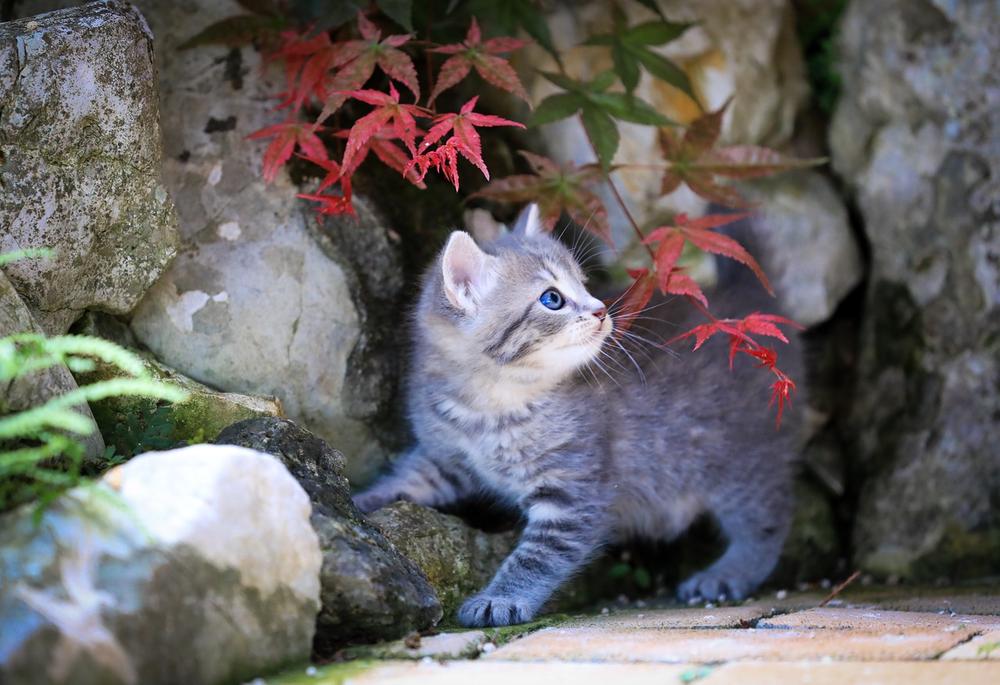How to Socialize a Kitten and Stop It From Being Anti-Social?

Want a sociable kitten?
Want a furball that's friendly with strangers?
An irresistible cutie who can charm even the grumpiest neighbor?
We get you, really. 🐱
It can be frustrating when your kitty hides under the bed, hissing at anyone who dares to approach.
But fear not, because today's guide has got you covered.
Keep reading, because otherwise, you might be stuck with a standoffish furball FOREVER.
Your Kitten's Early Experiences
If you want a well-behaved furry friend, expose them to different sounds and textures from the beginning. That way, they won't be afraid later on.
But socialization is about more than just making them less scared.
It's all about shaping their personality and behavior.
So ensure you give them positive experiences and interactions.
These early experiences will make your kitten accepting and easy to train in the long run. So don't stop now!
Siblings and mom are important teachers for kittens.
Did you know that kittens learn by watching their brothers and sisters and mom?
Yeah, it's true!
They learn how to control their claws and bites (no one wants to get scratched) and how to talk like a cat.
So let's give a shout-out to their family for being such great teachers!

Here's something you should know:
Staying with their family for 10-12 weeks gives them the most benefits.
They soak up all that knowledge during this time, so there's no need to rush the separation.
Let them enjoy their extended family time.
Introduce your kitten to non-cat friends early on.
Starting from week three, kittens start forming bonds not just with other cats but also with non-cat creatures.
How awesome is that?
But here's the thing: If you want your kitten to feel comfortable around non-feline pals, you gotta introduce them early. It's best to do it by week five. This will help them develop positive relationships and reduce any fear or aggression towards other animals.
Oh, and if you have a single cute little kitten, they might need some extra attention.
But here's a tip:
Adopting two kittens of similar ages can really help their learning and social development. They can become the best of buddies and learn together!
Main points I'll expand upon further down this article:
- Socializing older kittens is a time-consuming process.
- Create a safe environment and provide an adjustment period.
- Move slowly, speak softly, and reward positive experiences.
- Understand fear expressions and avoid mistaking them for aggression.
- Use food as an incentive and build trust through petting and playing.
- Touch, talk, and timing are important in socialization.
- Avoid negative interactions and punishment.
- Involve the whole family in socializing singleton kittens.
- Introduce the new kitten to other pets gradually and separate if needed.
- Teach children to respect the kitten's boundaries and end playtime when needed.
And now that your kitten has had some early socialization experiences, let me guide you through the next steps in ensuring their comfort and friendliness towards people and other pets...
Help Kittens Feel Comfortable
Helping kittens feel comfortable is essential for their well-being and social development. Here are some practical tips to create a safe and nurturing environment:
- Provide hiding spots in each room of the house, such as cardboard boxes with holes cut out. These give kittens a retreat when they feel overwhelmed or anxious, allowing them to observe their surroundings while feeling secure.
- Socialize older kittens (4-8 months) through a time-consuming process that teaches them how to interact with other cats, animals, and humans. Set up a crate off the floor, soothing them with familiar sounds, and gradually introduce them to everyday sights and sounds, creating an adjustment period.
- Techniques for socializing kittens include moving slowly, speaking softly, rewarding positive experiences, and avoiding scolding. It is essential to understand expressions of fear and not mistake them for aggression.
- Build trust by using food as an incentive, petting, playing, and individually holding kittens. Touching, talking, and timing all play important roles in socialization.
- Remember to avoid negative interactions and punishment, as these can hinder socialization progress.
- Providing suitable supplies like stainless steel food and water dishes contribute to creating a comfortable home environment for the kittens.
Your kittens will have the best opportunity for a happy and sociable life if you adopt these practices, ensuring their feelings of security and affection. 😺

And now let's explore how to properly introduce your kitten to other pets and ensure effective communication!
Introducing Your Kitten to Other Pets
Introducing your kitten to other pets can take a while, but if you follow these steps, you'll increase the chances of success:
- Start by swapping scents: Rub a cloth on one pet and transfer that smell to the other so they get used to it.
- Get the whole family involved: If you have just one kitten, make sure everyone spends time with them so they don't struggle to interact with other cats later.
- Take it slow: Introduce the new kitten to other pets gradually, giving them time to adjust and not overload them.
- Keep an eye on them at first: Watch their interactions closely during the initial meetings. If any aggression shows up, separate them.
- Don't leave them alone: Until they get along well, never leave the kitten and the other pets unsupervised to avoid conflicts or harm.
Socializing them properly requires patience and time, but following these steps will help smooth out the introduction between your kitten and other pets. 🐾
And here's where I come in with a valuable tip for you.

If you want to take your kitten's training to the next level, I encourage you to try out my step-by-step guide on training your cat to sit on command.
Mastering this skill will not only impress your friends and family, but it will also strengthen the bond between you and your feline companion.
So, why wait? Learn the secrets of perfecting the sit command in my article, 'How to Train Your Cat to Sit' today!
Your Kitten & Other People
When it comes to your kitten and other people, here are a few things to remember.
First, throw cat parties at home.
Invite trusted friends and family, but let the kitten approach them on their own terms.
Give the little one time to get comfortable with new faces. Patience is key.
And here's a great idea: let your kitten hang out with a neutered tom cat.
It helps build good relationships and improves social skills.
To avoid attachment to just one person, have different people handle your kitten.
This way, they'll get used to different individuals and won't fear strangers later in life.
Socialization is crucial for your kitten's development.
And remember, when it comes to your kitten and other people, I have written a comprehensive guide on how to address aggression towards guests and teach your cat appropriate social behavior.
If you're curious about solutions for these concerns, I highly recommend checking out My Cat Is Aggressive Towards Guests, which provides valuable insights and strategies that can help create a harmonious environment for you and your feline companion."
Kids & Kittens
When it comes to teaching children about kittens, body language and behavior cues are key.
The way a kitten flicks its tail or flattens its ears can tell you a lot about how it's feeling - if it's distressed or scared.
You need to make sure that these signals are understood by children, so they can adjust their actions accordingly.
But here's the thing, you also have to teach children to treat the kitten with respect and care.
They need to know that playtime should be stopped when the kitten has had enough.
By doing this, both the child and the kitten will stay safe and happy.
It's crucial for kids to understand that kittens are delicate creatures who need gentle handling, just like humans.
If the kitten shows signs of discomfort or stress, it's time for a break.
Creating an environment where both the child and the kitten can enjoy each other's company without harm is what it's all about.
Keeping Kittens Safe
Creating a safe environment for your kitten is crucial.

You want them to feel secure and protected.
Here are some tips to ensure the safety of your furry little friend:
- Create vertical spaces in your home, such as cat trees or shelves, to provide safe areas for kittens to observe their surroundings and escape perceived threats.
- Take precautions when handling frightened kittens by wearing gloves or protective clothing. Tightly grasping the fur on the back of their necks can give you better control.
- Use diluted bleach solutions in small amounts for cleaning, and keep toxic cleaning products out of their reach.
- Secure windows, vents, reclining chairs, and other potential hazards to prevent accidents.
- Clean up pet mistakes properly using baking soda and regular detergent for machine-washable items.
- Familiarize kittens with a cat carrier through short trips that end in positive experiences.
- Block off areas of the house that are off-limits, and keep smaller pets out of reach for their safety.
- When leaving the house, try not to make a big fuss to minimize stress for the kitten.
- Never punish a kitten for soiling the house due to separation anxiety. Instead, gradually teach them to tolerate short absences by leaving them alone in a room and extending the time apart.
- Stay informed about pet health through weekly tips and insights from veterinarians.
By following these practical tips, you can create a safe and happy environment for your kitten.
And that wraps up today's article.
If you wish to read more of my useful articles, I recommend you check out some of these: How Do Mother Cats Discipline Their Kittens, Cat Depressed After New Kitten, Cat Behavior After Mating, How Long Does It Take to Litter Train a Kitten, and What to Do if Your Indoor Cat Gets Outside
Talk soon,
-Sarah Davis